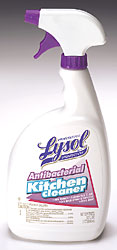Food is 21st century snake oil. In an era of unprecedented affluence, consumers now choose among a cacophony of low fat, enhanced nutrient staples reflecting a range of political statements and perceived lifestyle preferences, far beyond dolphin free tuna.
 In fall 2000, I contacted Procter & Gamble to ask for the data substantiating the claim that Fit would eliminate 99.9 per cent of bacteria on fresh produce,
In fall 2000, I contacted Procter & Gamble to ask for the data substantiating the claim that Fit would eliminate 99.9 per cent of bacteria on fresh produce,
After a bunch of calls to various PR types I got hooked up with some scientists at P&G in Cincinnati, who verbally told me that sample cucumbers, tomatoes and the like were grown on the same farm in California, sprayed with chemicals that would be used in conventional production, and then harvested immediately and washed with Fit or water. The Fit removed 99.9 per cent more, or so the company claimed, because no data was ever forthcoming.??????
One problem. Many of the chemicals used have harvest after dates, such as the one tomato chemical that must be applied at least 20 days before harvest. Residue data on produce in Canadian stores reveals extremely low levels, in the parts per million or billion. So that 99.9% reduction is really buying consumers an extra couple of zeros in the residue quantity, all well below health limits.
The Wall Street Journal picks up on this theme today, stating that everything from hand-sanitizing liquids to products like computer keyboards, shopping carts and tissues tout that they kill 99.9%, or 99.99%, of common bacteria and fungi.
But some of these numbers look like the test scores in a class with a very generous grading curve. They often don’t include all pesky germs, and are based on laboratory tests that don’t represent the imperfections of real-world use.
Human subjects, or countertops, in labs are cleaned first, then covered on the surface with a target bug. That is a far cry from a typical kitchen or a pair of grimy hands.
"The 99.99% message is more powerful among consumers than ‘antibacterial’ or ‘germ kill’ alone," Maria Lovera, senior brand manager of skin care for Playtex Products Inc., maker of Wet Ones antibacterial wipes, wrote in an email.
In a study soon to be published, University of New Mexico biochemist Laurence Cole found that in two of three brands’ home-pregnancy tests, fewer than two-thirds of pregnancies among women who had missed their periods were detected.
 To cite a 99.9% fatality rate, manufacturers don’t have to kill 99.9% of all known bugs. Regulations don’t require them to disclose which bugs they exterminate, just that the products are effective against a representative sample of microbes. For instance, many products can’t kill Clostridium difficile, a gastrointestinal scourge, or the hepatitis A virus, which inflames the liver. Yet by killing other, more common bugs, they can claim 99.9% effectiveness.
To cite a 99.9% fatality rate, manufacturers don’t have to kill 99.9% of all known bugs. Regulations don’t require them to disclose which bugs they exterminate, just that the products are effective against a representative sample of microbes. For instance, many products can’t kill Clostridium difficile, a gastrointestinal scourge, or the hepatitis A virus, which inflames the liver. Yet by killing other, more common bugs, they can claim 99.9% effectiveness.


















